RIA ETF Trends Report - Q3 2025
.avif)
.avif)
Table of Contents
- Introduction
- Executive Summary
- Are RIAs Concentrating or Diversifying ETF Allocations?
- ETF Turnover Trends Among RIAs
- Top 10 Fastest-Growing ETF Issuers Among RIAs
- Top 10 Fastest-Growing ETFs Among RIAs
- Top 10 High-Fee ETFs Gaining RIA allocators
- Top 10 Newly Launched ETFs Gaining RIA Adoption
- Top 10 ETF Categories with the Highest RIA Growth
- Adoption of Thematic ETFs Among RIAs
Introduction
The third quarter of 2025 showed clear acceleration in how RIAs are expanding and refining their ETF usage. Advisors continued adding new ETFs at higher rates than in prior quarters, while simultaneously leaning into themes tied to digital assets, technology innovation, municipal income, and real-asset hedges. Rather than rotating away from existing exposures, RIAs layered in new strategies - highlighting a market defined more by portfolio expansion than consolidation.
Our Q3 analysis draws from 13F filings, ETF characteristics, and the AdvizorPro RIA database across 4,774 consistently reporting RIAs. The results reveal a market that is broadening: more ETFs, more issuers receiving attention, more categories gaining adoption, and more thematics showing early traction.
Across Q3, three macro themes emerged:
- ETF diversification momentum strengthened.
More RIAs increased their ETF count than in any quarter so far in 2025, and turnover data shows advisors are adding new ETF types far more often than they are deleting old ones. - Innovation- and risk-management themes drove category and fund-level winners.
Digital assets, AI technology, defense, industrial reshoring, and precious metals all captured new advisor demand - while municipal income and hedged fixed income provided stability. - Competitive dynamics shifted sharply quarter-over-quarter.
Virtually all “fastest-growing” ETF and issuer lists saw complete resets from Q2 to Q3, underscoring how rapidly RIAs reposition portfolios based on macro trends and thematic catalysts.
Together, these insights show that RIAs are embracing a structurally multi-thematic, multi-issuer ETF landscape - where innovation, income, and diversification all play essential roles in portfolio construction.
Executive Summary
Q3 2025 marked a renewed acceleration in ETF adoption among RIAs. Advisors increased the breadth of their ETF usage, added new thematic and alternative exposures, and strengthened defensive allocations - all while maintaining low turnover and high retention of existing ETF positions.
Q3 2025 Key Findings
- ETF adoption broadened meaningfully across the RIA channel.
Nearly 59% of RIAs increased their ETF count (up from 57.8% in Q2), while only 18.6% decreased exposure. The average ETF count rose from 69.9 → 72.7, and median holdings increased from 38 → 40 confirming continued expansion rather than consolidation. - Digital assets delivered the strongest growth of any theme or category.
Ethereum-focused ETFs (ETHA +199 RIAs; FETH +52; ETH +66) and Bitcoin products (IBIT +146) were the top growth engines across all fund types. Digital Assets as a category grew +5.6%, and crypto thematics saw the largest rise in total appearances. - Technology innovation themes accelerated sharply.
Defense tech (SHLD +136), AI/tech subsectors (BAI +83; ARTY +89), and industrial reshoring (ITA +107) surged. Compared with Q2’s broad-tech tilt, Q3 saw diversification into specialized subsectors aligned with AI, cybersecurity, defense, and semiconductors. - Income and defensive exposures strengthened.
Equity Precious Metals added +115 RIAs; Muni California Intermediate grew +26%; and hedged equity and high-yield muni categories posted steady gains. Q3 showed RIAs balancing thematic growth exposure with hedges against inflation, rates, and volatility. - High-fee ETFs with differentiated payoff structures continued to attract advisors.
Preferred income (PFFA +16%), option-overlay income (BUFD +5), selective leveraged tools (NVDL +4), and inflation-informed bonds (IVOL +2) led the high-fee segment. Compared with Q2’s innovation-heavy list, Q3 showed a tilt toward stability, yield, and risk management. - Newly launched ETFs showed broad, evenly distributed adoption.
SPYI (+36 RIAs) continued to dominate new launches, while mid-cap, small value, EM equity, munis, and alt-income strategies all saw steady increases. Q3 adoption was more balanced across categories versus Q2’s spike-driven leaders.
Bottom Line
RIAs leaned into both conviction (digital assets, tech innovation) and caution (munis, precious metals, hedged income) in Q3, producing a quarter defined by expansion rather than rotation. The RIA market remains far from saturation, and the issuers seeing the strongest success are those delivering differentiated, outcome-driven tools aligned with the macro environment.
Are RIAs Expanding or Consolidating ETF Exposure?
Tracking how the number of ETFs held per RIA firm changed from Q2 to Q3 2025
This analysis examines whether RIAs are consolidating into fewer ETF positions or broadening their use of ETFs to better serve clients. By tracking firm-level ETF counts and quarter-over-quarter changes in position behavior, we can identify whether advisors are moving toward greater concentration or increased diversification.
Change in Number of ETFs Held per RIA (Concentration vs Expansion)
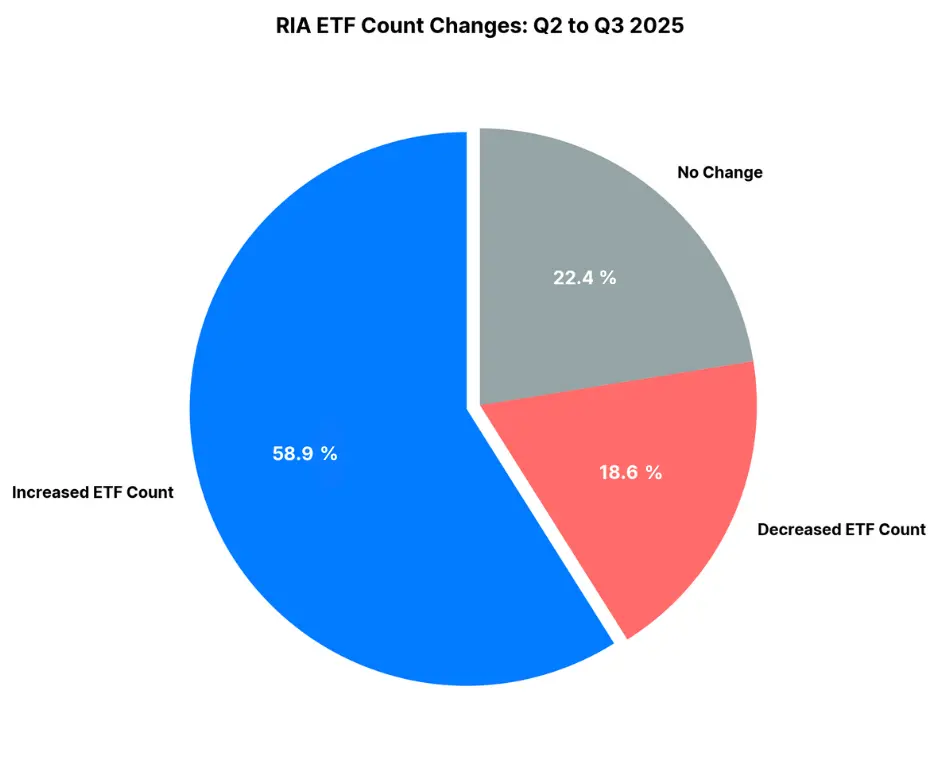

Key Takeaways
- Diversification momentum strengthened in Q3 – 58.94% of RIAs increased the number of ETFs they hold, up slightly from 57.84% last quarter. This reinforces that advisors continue to add new strategies rather than rotate within a fixed set of holdings.
- Consolidation continues to decline – Only 18.61% of RIAs reduced their ETF count, a meaningful drop from 22.24% in Q2. Advisors are unwinding fewer ETF positions and maintaining broader exposure across asset classes.
- More RIAs kept allocations unchanged – 22.46% saw no change in ETF count (vs. 19.92% in Q2), indicating a cohort of firms maintaining steady allocations while still adding selectively around the edges.
- ETF usage per RIA continues to rise – The average ETF count broke above 70 from Q2’s 69.9 → 72.7 (+4.1%), and the median rose from 38 → 40 (+5.3%). These consistent increases underscore a continued trend toward broader ETF adoption across independent advisors.
ETF Turnover Trends Among RIAs
Measuring how frequently RIAs added or removed ETFs from their portfolios over the past quarter (Q2 2025 - Q3 2025)
ETF turnover offers a window into how actively RIAs are adjusting their ETF allocations - whether by incorporating new funds, trimming existing positions, or maintaining stable, long-term holdings. By analyzing turnover ratios and the volume of ETFs added or dropped, we can evaluate the balance between reallocation activity and retention across RIA portfolios.
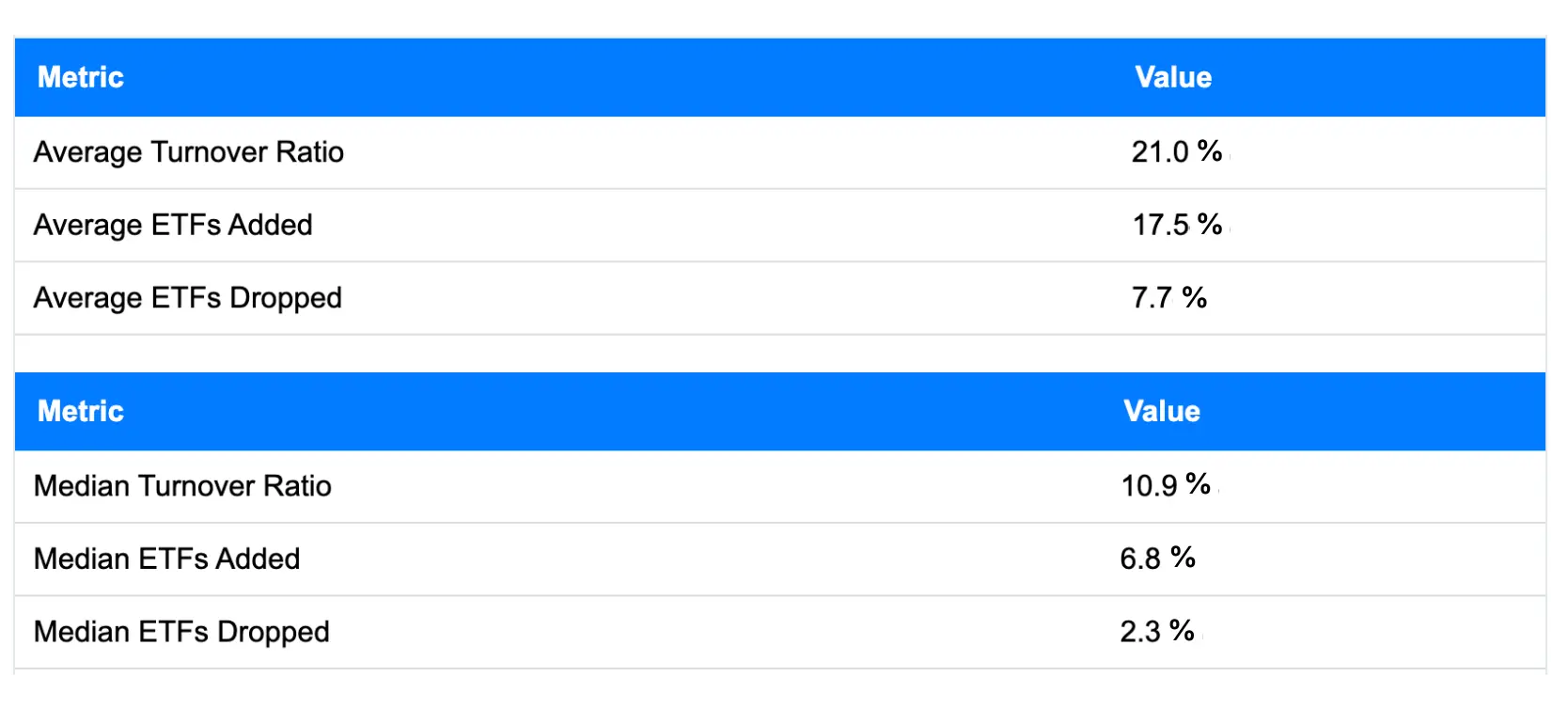
Key Takeaways
- RIAs are expanding into new ETF types far more than they are abandoning old ones - “ETF % Added” (17.54%) more than doubles “ETF % Dropped” (7.74%). This metric measures unique ETFs added relative to prior holdings, and confirms advisors are broadening their product toolkit rather than rotating out of existing exposures.
- Turnover is concentrated among a smaller set of highly active RIAs - The average turnover ratio (21.05%) is nearly double the median (10.99%), indicating that most RIAs maintain relatively stable ETF lineups while a minority of RIAs drive the bulk of trading activity.
- Most RIAs are taking an incremental approach - Median ETF % Added (6.82%) and Median ETF % Dropped (2.38%) show that a typical RIA introduced only a few new ETF types and removed almost none. This signals deliberate, slow-paced adoption of new exposures rather than wholesale reallocations.
- Low deletion rates signal high ETF retention and strong long-term conviction - The low Average and Median “% Dropped” values demonstrate that RIAs prefer to layer in additional strategies rather than unwind existing ETF positions, reinforcing the stickiness and durability of ETF allocations within advisory portfolios.
Metrics Calculation
These metrics assess how frequently RIAs adjust their ETF holdings, indicating trends in portfolio turnover, fund adoption, and retention.
Turnover Ratio:
- Measures how often ETFs are swapped out in a portfolio
- Formula: (Added ETFs + Dropped ETFs) ÷ (Average number of ETFs held)
- High ratio = frequent changes; Low ratio = stable portfolio
ETF % Added:
- Shows what percentage of new ETFs were added compared to previous holdings
- Formula: Added ETFs ÷ Previous ETFs
- High percentage = actively adding new ETF types
ETF % Dropped:
- Shows what percentage of ETFs were removed compared to previous holdings
- Formula: Dropped ETFs ÷ Previous ETFs
- High percentage = actively removing ETFs from portfolio These metrics highlight whether RIAs actively trade or maintain long-term ETF positions.
Top 10 Fastest-Growing ETF Issuers Among RIAs
ETF issuers with the highest percentage growth in RIA allocators over the past quarter (Q2 2025 → Q3 2025)
This analysis highlights the ETF issuers experiencing the strongest percentage growth in RIA adoption from Q2 to Q3 2025. Rankings are based on quarter-over-quarter percentage change in the number of RIAs allocating to each issuer, with a minimum threshold of 50 RIA allocators in Q2.
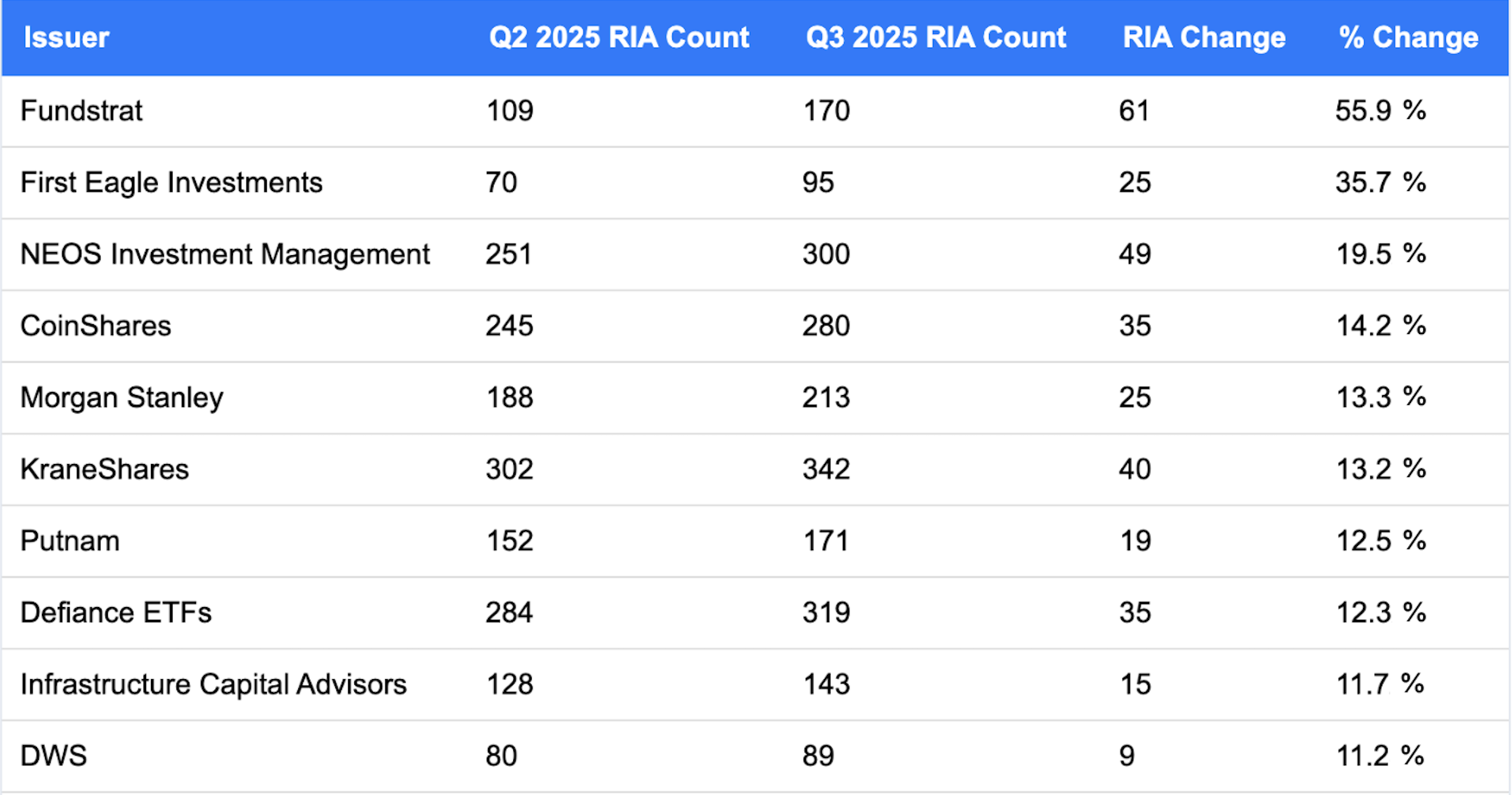

Key Takeaways:
- Fundstrat emerges as the quarter’s breakout winner - Fundstrat posted the strongest issuer-level growth of the quarter (+56%), driven by advisor rotation into thematic equity and macro-sensitive strategies. This mirrors last quarter’s rise of specialty issuers (BondBloxx, Defiance), but Fundstrat’s placing signals growing RIA appetite for research-driven, active thematic issuers.
- Income and options-overlay specialists continue strong momentum - NEOS (+19.5%), First Eagle (+35.7%), and Putnam (+12.5%) all posted double-digit growth, underscoring that options-overlay income, structured equity, and active income mandates remain among the most preferred demand drivers in the RIA channel. This is consistent with Q2 themes, where YieldMax, Neos, and option-based issuers dominated the leaderboard.
- Digital asset issuers maintain RIA traction even with slower relative growth - CoinShares (+14.3%) and KraneShares (+13.3%) appeared again in the top 10 after strong digital-asset momentum in Q2. While percentage growth moderated compared to last quarter’s adoption, the continued presence of these issuers indicates that crypto and blockchain exposures are becoming a growing sleeve in RIA portfolios.
- Repeat appearance rate stays low, highlighting how fast the issuer leaderboard rotates - Only a small subset of Q2 leaders reappeared in Q3 (e.g., Defiance, NEOS), reinforcing a persistent trend: RIA issuer demand remains highly dynamic, with ~70–80% turnover quarter-to-quarter. This turnover underscores how RIAs shift quickly to follow macro catalysts - rather than remaining loyal to issuer brands alone.
Top 10 Fastest-Growing ETFs Among RIAs
ETFs with the highest percentage growth in RIA allocators over the past quarter (Q2 2025 - Q3 2025)
This analysis highlights the 10 ETFs with the highest percentage growth in RIA allocators from Q2 2025 to Q3 2025. The rankings are based on year-over-year percentage change, with ETFs required to have a minimum of 50 RIA allocators in Q2 2025 to be included.

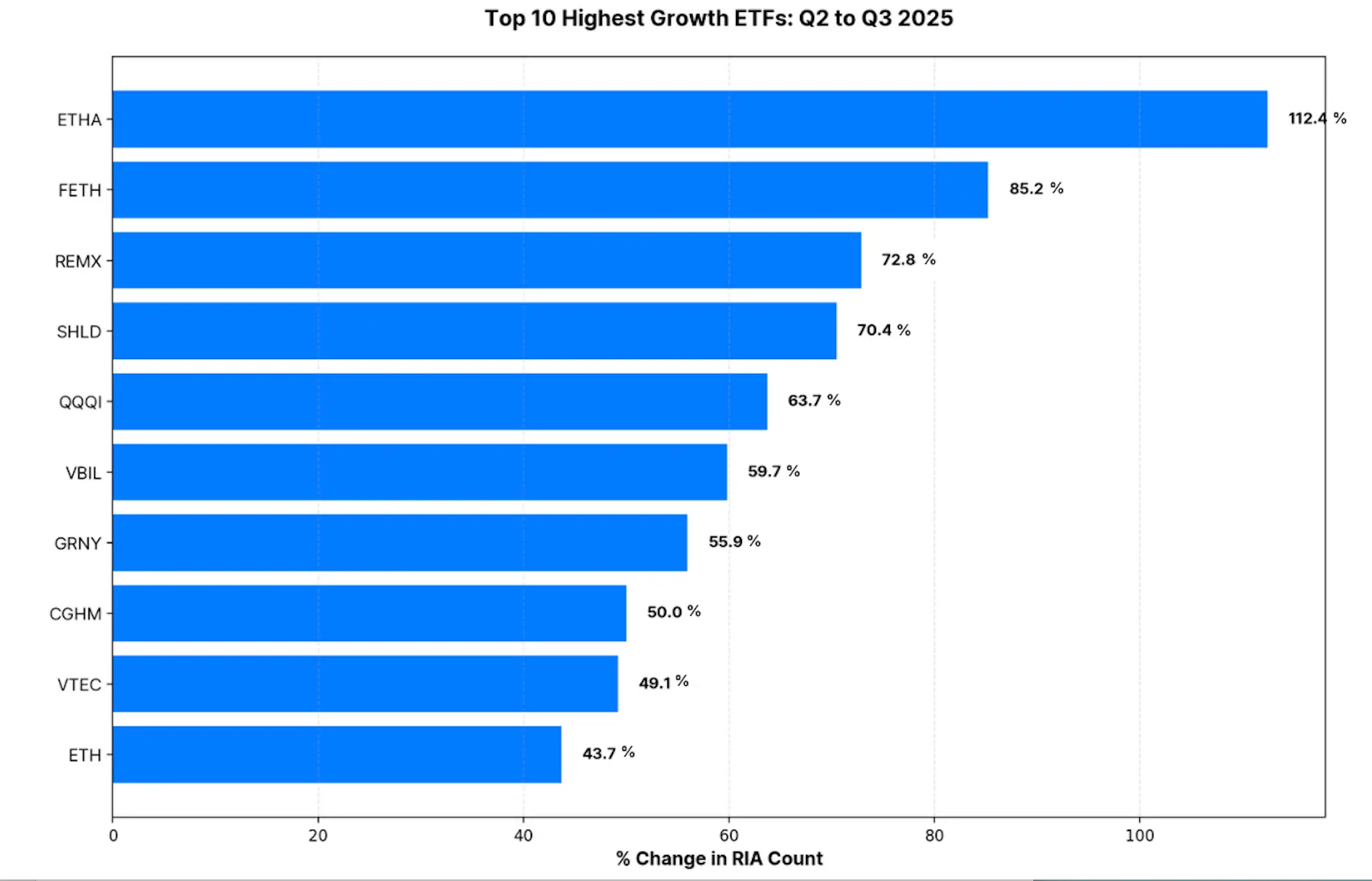
Key Takeaways:
- Digital assets lead by a wide margin. Ethereum-focused ETFs (ETHA, FETH, ETH) posted the strongest percentage growth this quarter, reinforcing a clear shift toward crypto exposure among RIAs. Adoption accelerated and broadened beyond Bitcoin versus Q2, suggesting interest is moving from exploratory to sustained allocation.
- Rotation from macro exposures to thematic and income strategies. Q3’s fastest-growing ETFs moved away from the global bond and foreign equity themes that dominated Q2. Instead, RIAs favored technology subsectors, derivative-income products, precious metals, and California muni exposure, reflecting a more targeted mix of growth, income, and hedging tools.
- Another quarter of complete turnover in the leaders. None of Q2’s Top 10 ETFs reappeared in the Q3 list. This full refresh underscores how opportunistic RIA flows are, with advisors quickly rotating into the themes most aligned with current catalysts—from global bonds last quarter to crypto, metals, and income overlays this quarter.
- Top-end growth accelerated quarter-over-quarter. The fastest-growing Q3 ETFs posted higher percentage gains than last quarter’s leaders (with several above 70–110%), indicating that RIA demand for the right exposures is not plateauing.
Top 10 High-Fee ETFs Gaining RIA Allocators
ETFs in the top 10% of expense ratios with the highest RIA growth over the past quarter (Q2 2025 - Q3 2025)
This analysis highlights the 10 high-fee ETFs (top decile by expense ratio) that saw the strongest percentage increase in RIA allocators from Q2 to Q3 2025. All funds included had a minimum of 50 RIA allocators in Q2.
Top 10 High-Fee ETFs Gaining RIA Allocators
ETFs in the top 10% of expense ratios with the highest CRD growth from Q2 2025 to Q3 2025 (min 50 CRDs).
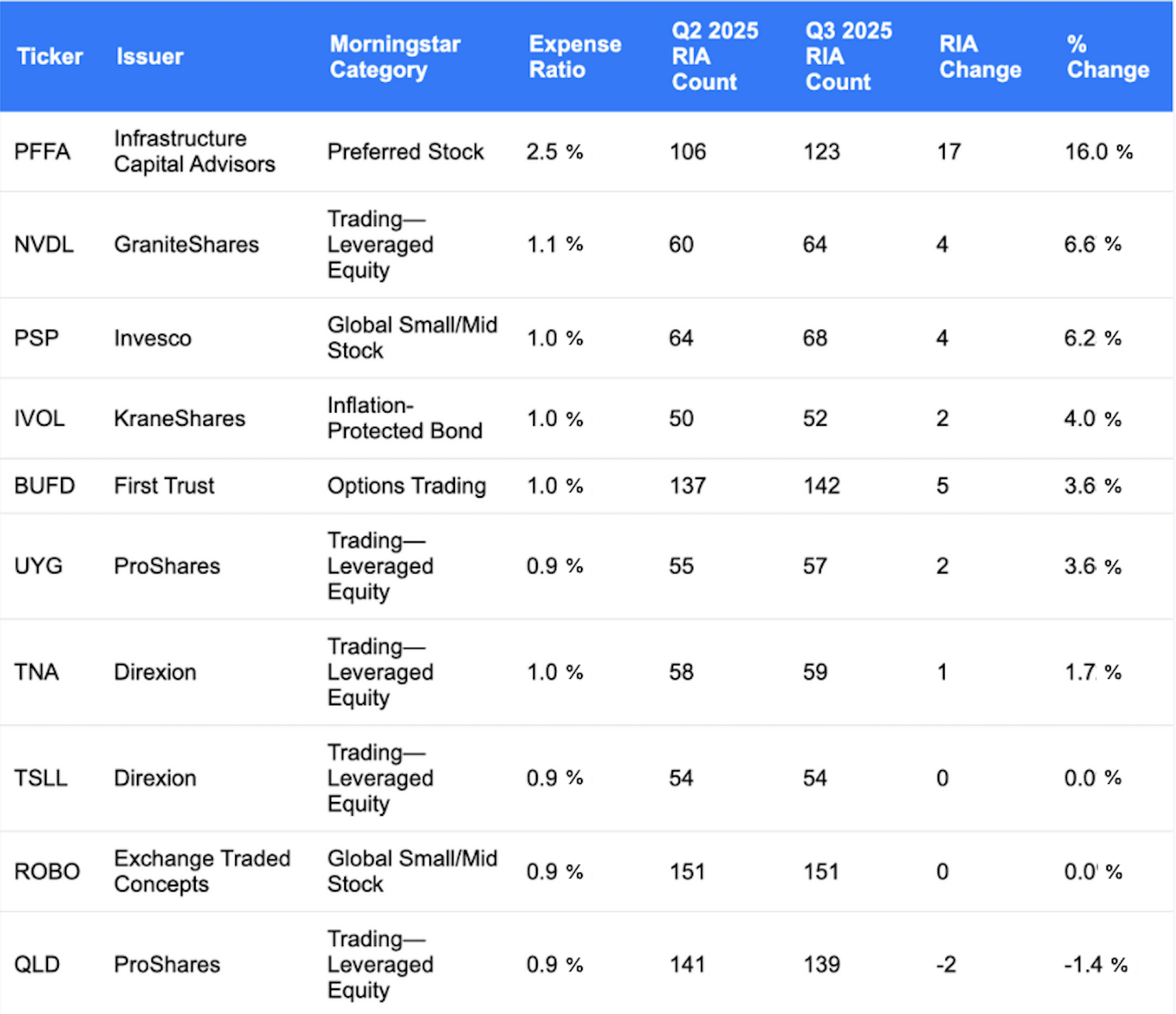
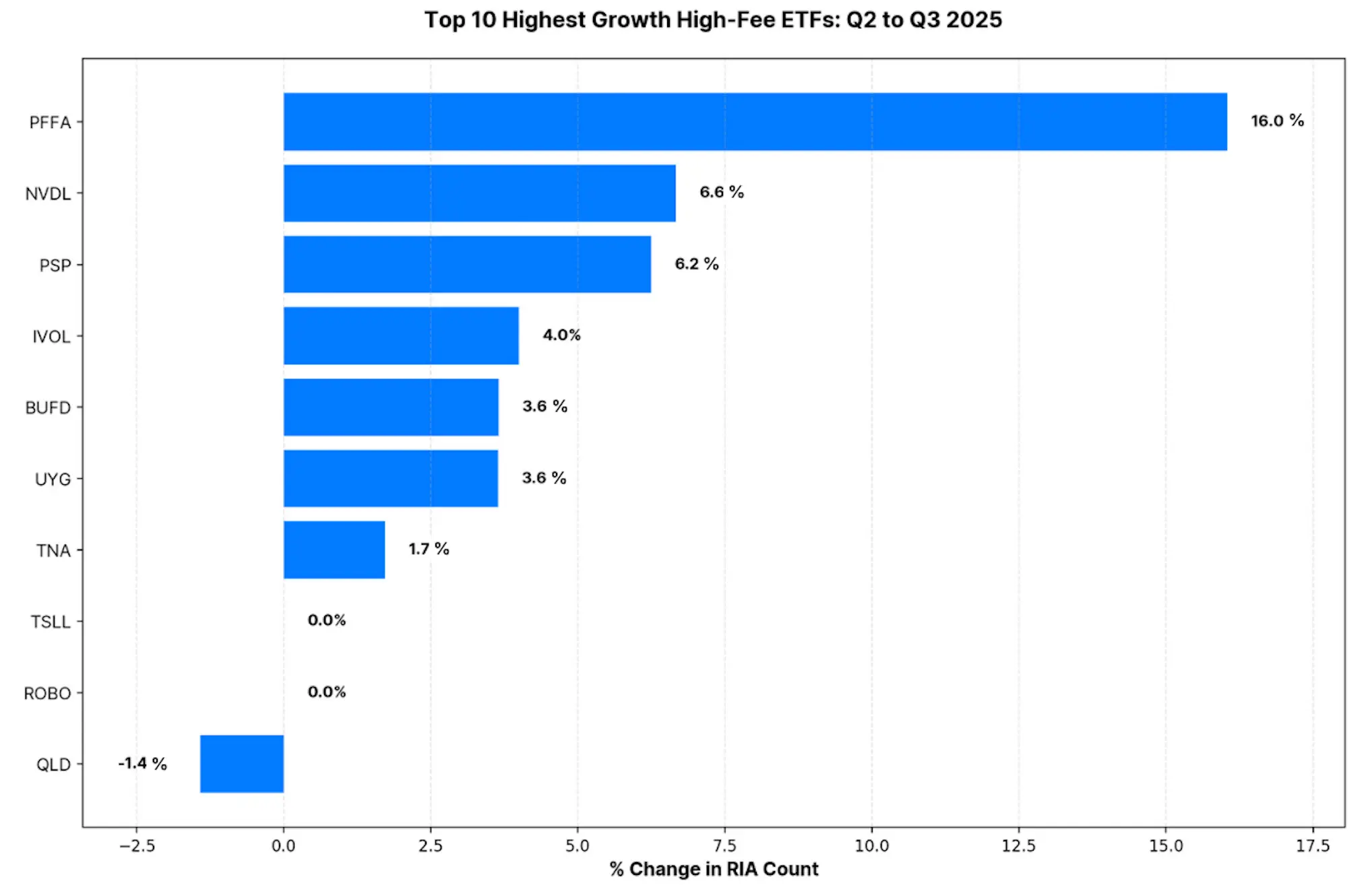
Key Takeaways:
- High-fee ETFs with income or yield-enhancement features led the quarter. Preferred stock (PFFA, +17 RIAs, +16%) and option-based income funds like BUFD (+5, +3.7%) continue to draw steady advisor demand. Even within the top-fee decile, RIAs are prioritizing products that provide yield, downside buffers, or defensive positioning.
- Leveraged equity remains resilient despite fee sensitivity. GraniteShares’ NVDL (+4 RIAs, +6.7%) and ProShares’ UYG (+2, +3.6%) show that RIAs are still allocating to tactical leveraged strategies - though growth rates slowed sharply compared to last quarter’s surge in leveraged trading products.
- More defensive tilt vs. last quarter’s innovation-driven mix. Unlike Q2 - where tech, buffered outcomes, and innovation-oriented products dominated - Q3’s leaders tilt toward higher-yield equity income, global small/mid-cap funds, inflation-sensitive bonds, and modest leveraged equity strategies. This signals a more conservative stance among RIAs as macro uncertainty continued.
Top 10 Newly Launched ETFs Gaining RIA Adoption
The fastest-growing ETFs introduced within the last three years based on RIA adoption (Q2 2025 - Q3 2025)
This analysis highlights the top 10 ETFs launched within the past three years that experienced the largest increase in RIA allocator adoption from Q2 2025 to Q3 2025. These ETFs are ranked by absolute RIA allocator growth, with a minimum of 50 RIA allocators in Q2 2025. These results help identify which recent fund launches are finding product–market fit among independent advisors - and what categories are seeing early traction.
Top 10 Newly Launched ETFs Gaining RIA Adoption (with Value Change)
ETFs launched within the last 3 years, ranked by CRD growth and value change from Q2 2025 to Q3 2025.
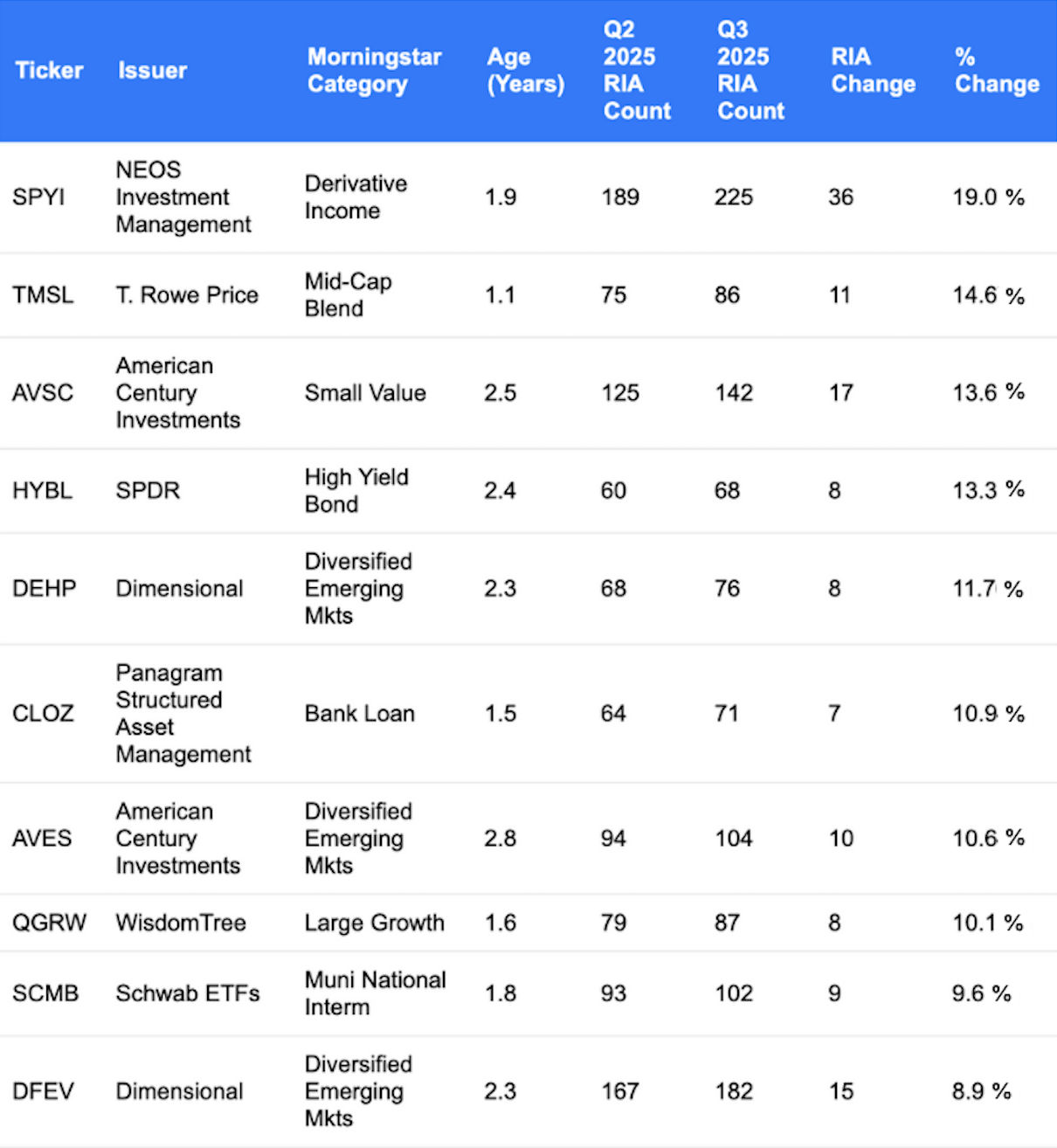

Key Takeaways:
- Derivative-income strategies remain the standout. NEOS’ SPYI again leads all newer ETFs in RIA adoption (+36 RIAs). This reinforces the structural demand RIAs have for buffered-income and option-overlay strategies introduced in the last few years.
- Mid-cap, small-value, and high-yield themes see steady, broad-based traction. Funds like TMSL (Mid-Cap Blend), AVSC (Small Value), and HYBL (High Yield Bond) were among the strongest climbers, showing advisors continue to add balanced equity and fixed-income exposures - not just niche thematics.
- Emerging-markets diversification continues. Dimensional’s DEHP and DFEV both gained new RIA allocators (+8 and +15), suggesting RIAs are selectively adding EM exposure.
- Q3 shows more consistent growth vs. Q2’s spike-heavy mix. Compared with Q1→Q2, where growth was heavily concentrated in a few products, Q3 adoption is more evenly distributed across categories - from alternatives to munis to large-growth equity - indicating a broader search for diversified exposures among newer ETF launches.
Top 10 ETF Categories with the Highest RIA Growth
Morningstar categories with the largest increase in RIA allocators over the past quarter (Q2 2025 - Q3 2025)
This analysis ranks the top 10 Morningstar categories by percentage increase in RIA allocators from Q2 2025 to Q3 2025. The data reflects new advisor adoption - not larger allocations from existing investors. These shifts highlight which asset classes and themes are gaining the most traction among RIAs as macro trends, rate expectations, and risk appetites evolve.

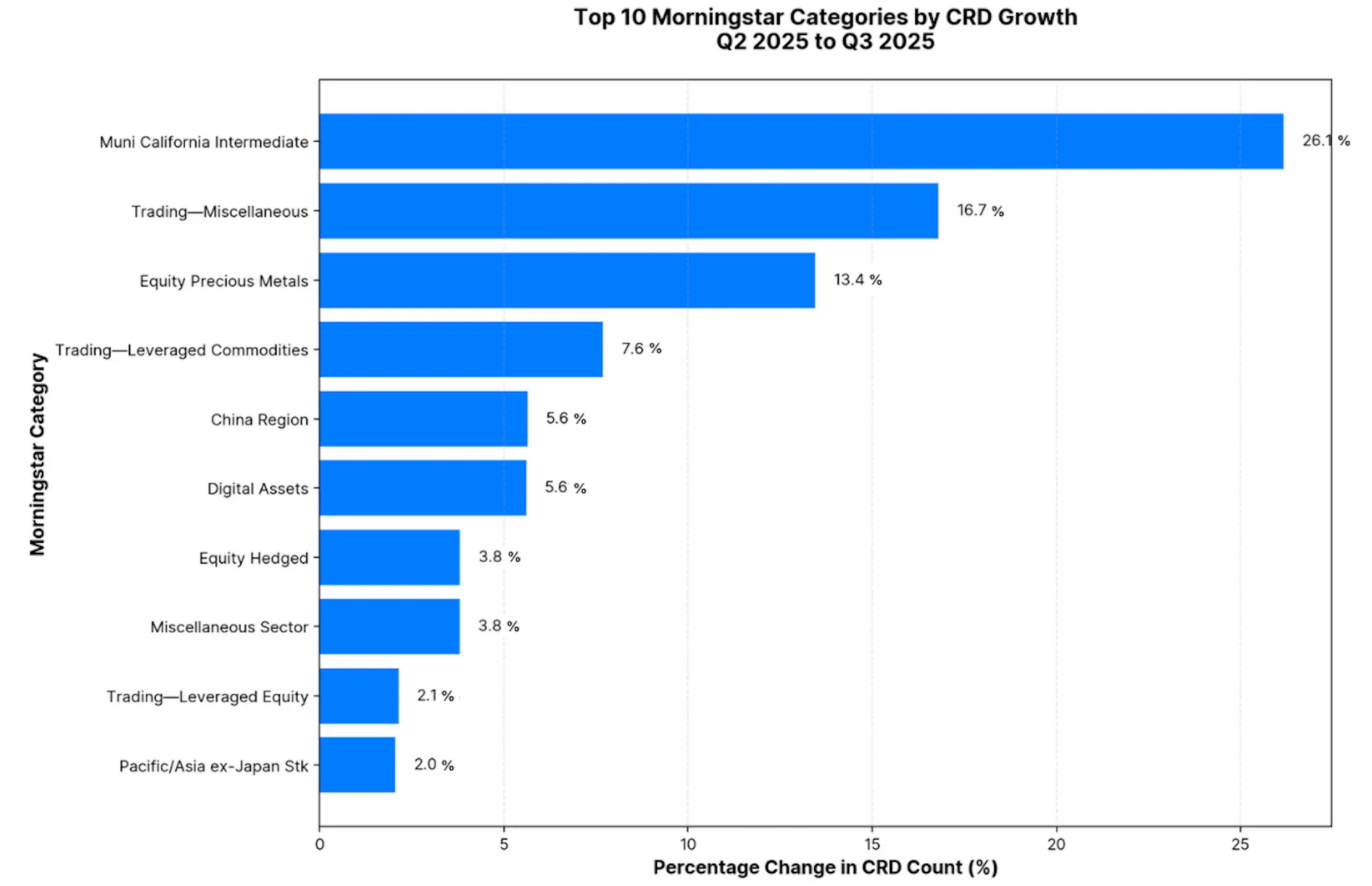
Key Takeaways:
- Defensive and income-oriented categories lead growth. Muni California Intermediate (as a proxy for state-specific munis) and Trading—Miscellaneous topped the list with double-digit gains, signaling RIAs’ continued preference for tax-efficient income and flexible trading tools in a volatile rate environment.
- Hard-asset themes remain resilient. Equity Precious Metals posted another strong quarter (+13.5%), underscoring ongoing demand for real-asset hedges amid geopolitical uncertainty and inflation concerns.
Broader diversification across niche exposures. Moderate but steady growth in categories like Digital Assets, China Region, Miscellaneous Sector, and Equity Hedged shows RIAs expanding into specialized and non-traditional exposures rather than concentrating solely in broad-market ETFs.
Growing Adoption of Thematic ETFs Among RIAs
Growth in Thematic ETF Adoption Among RIAs (Q2 2025 - Q3 2025)
Thematic ETFs are seeing strong growth among RIAs, reflecting increasing investor demand for specialized exposure in technology, digital assets, and alternative strategies. Our analysis highlights the top 10 thematic categories and individual ETFs that experienced the highest growth in appearances in RIA portfolios from Q2 2025 to Q3 2025.
Top Thematic ETFs by Growth in Appearance (Q2 2025 → Q3 2025)
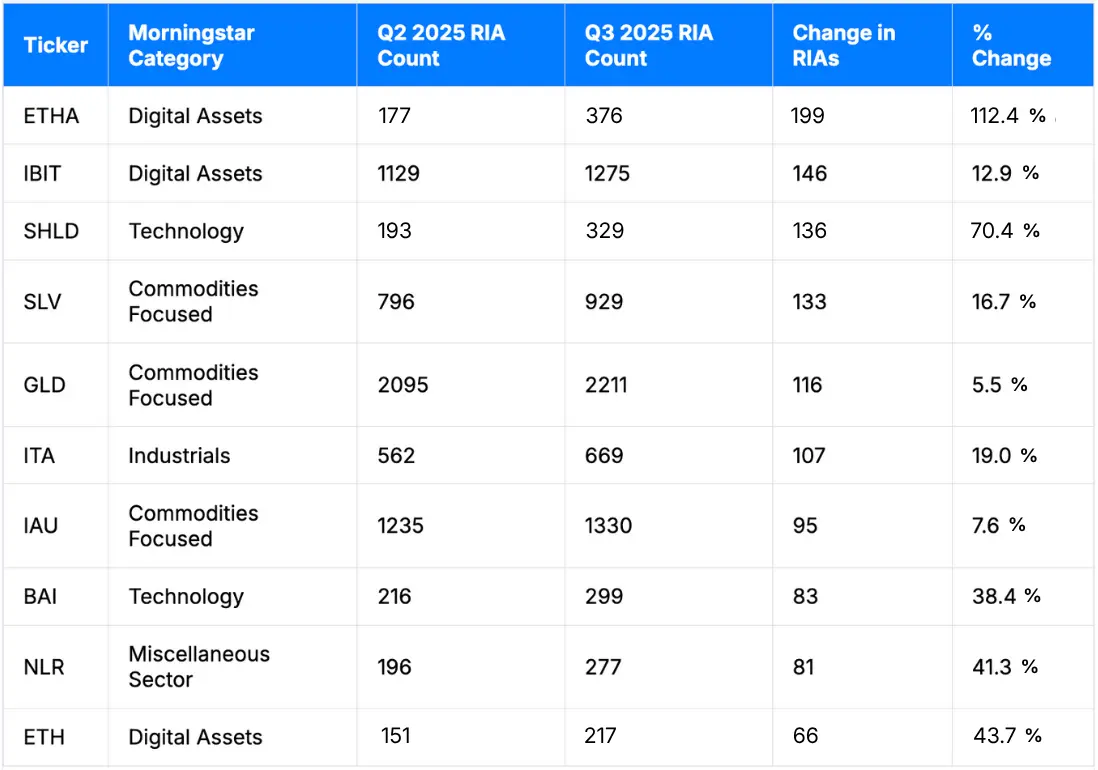
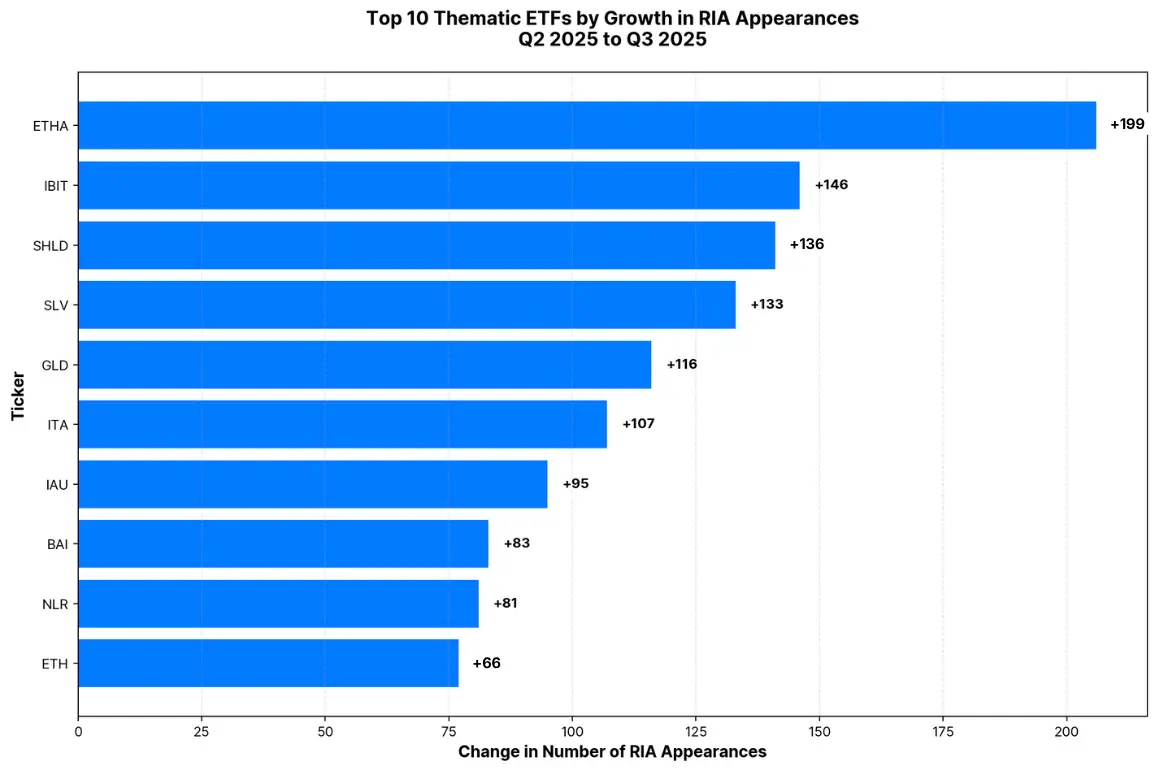
Key Takeaways:
- Digital assets dominate thematic growth. Ethereum-focused ETFs led all thematics, with ETHA adding +199 RIAs (+112%) and ETH adding +66 (+43%). Bitcoin’s IBIT also posted strong gains (+146, +13%). Compared with Q2 - when Bitcoin drove most crypto momentum - Q3 shows widening adoption across the broader digital asset ecosystem.
- Defense and industrial themes surge. Defense tech (SHLD, +136 RIAs, +70%) and industrials (ITA, +107 RIAs, +19%) saw major adoption jumps, reflecting advisor positioning around geopolitical risk, reshoring trends, and increased defense-related spending.
- Commodities remain a persistent hedge. SLV (+133 RIAs, +17%) and GLD (+116, +5.5%) continue to serve as structural inflation and volatility hedges. Growth rates moderated from Q2’s commodity spike, but gold and silver remain core, stable components of RIA thematic allocations.
- Thematic expansion continues beyond tech & crypto. Non-traditional thematics such as Miscellaneous Sector (NLR, +81 RIAs, +41%) highlight RIAs allocating into more specialized or cross-sector themes. The broader dispersion of thematics - compared with Q2’s tighter clustering—signals growing appetite for differentiated, niche exposures.
Conclusion
Q3 2025 reaffirmed that RIA ETF adoption is both expanding and evolving. Advisors are not simply adding more ETFs, they are curating allocations with a stronger emphasis on thematic relevance, structural innovation, and risk aware positioning. Digital assets and AI driven subsectors have moved into mainstream consideration, while municipal income, precious metals, and hedged strategies continue serving as portfolio stabilizers.
Across issuers, categories, and individual ETFs, the data shows:
• Rapid rotation in “fastest growing” products and issuers, with near total turnover vs. Q2
• Growing specialization in technology such as AI, defense tech, and semiconductors
• Durable demand for income overlays, structured payoffs, and real assets
• Increasing comfort with emerging and alternative ETF structures
• Clear broadening of ETF counts and thematic participation across RIAs
Looking ahead to Q4 2025 and early 2026, three dynamics appear likely to shape RIA ETF behavior:
• Continued normalization of digital assets as a structural sleeve rather than an opportunistic trade
• Deepening adoption of outcome oriented strategies including buffered income, derivative overlays, and targeted yield
• Further thematic specialization across AI infrastructure, cybersecurity, defense technology, industrial reshoring, and other macro aligned niches
As RIAs seek to differentiate client portfolios, manage risk, and express conviction views, ETFs remain the tool of choice. Q3’s results reinforce that ETF innovation across asset classes, payoff structures, and thematic exposures is meeting advisors exactly where their needs are growing, with more flexibility, more precision, and more ways to build resilient, forward looking allocations.
The continued evolution of the ETF landscape makes timely, accurate advisor intelligence essential for understanding where demand is shifting and which strategies are gaining traction. Teams looking to deepen their understanding of advisor behavior can explore our insights in the Advisor Demographics Report or review market wide trends captured in the Mid Year RIA Growth Update. For more targeted prospecting strategies, the AI List Matching for RIA Prospecting guide offers an in depth look at how segmentation improves engagement.
If you want to keep pace with ETF adoption trends and access verified advisor and firm insights as soon as they shift, AdvizorPro can help your team move faster and with more clarity.
Start your free trial and unlock real time intelligence across the advisor ecosystem.
Related Post
Related insights you may find valuable
.avif)
.avif)

.avif)


.webp)